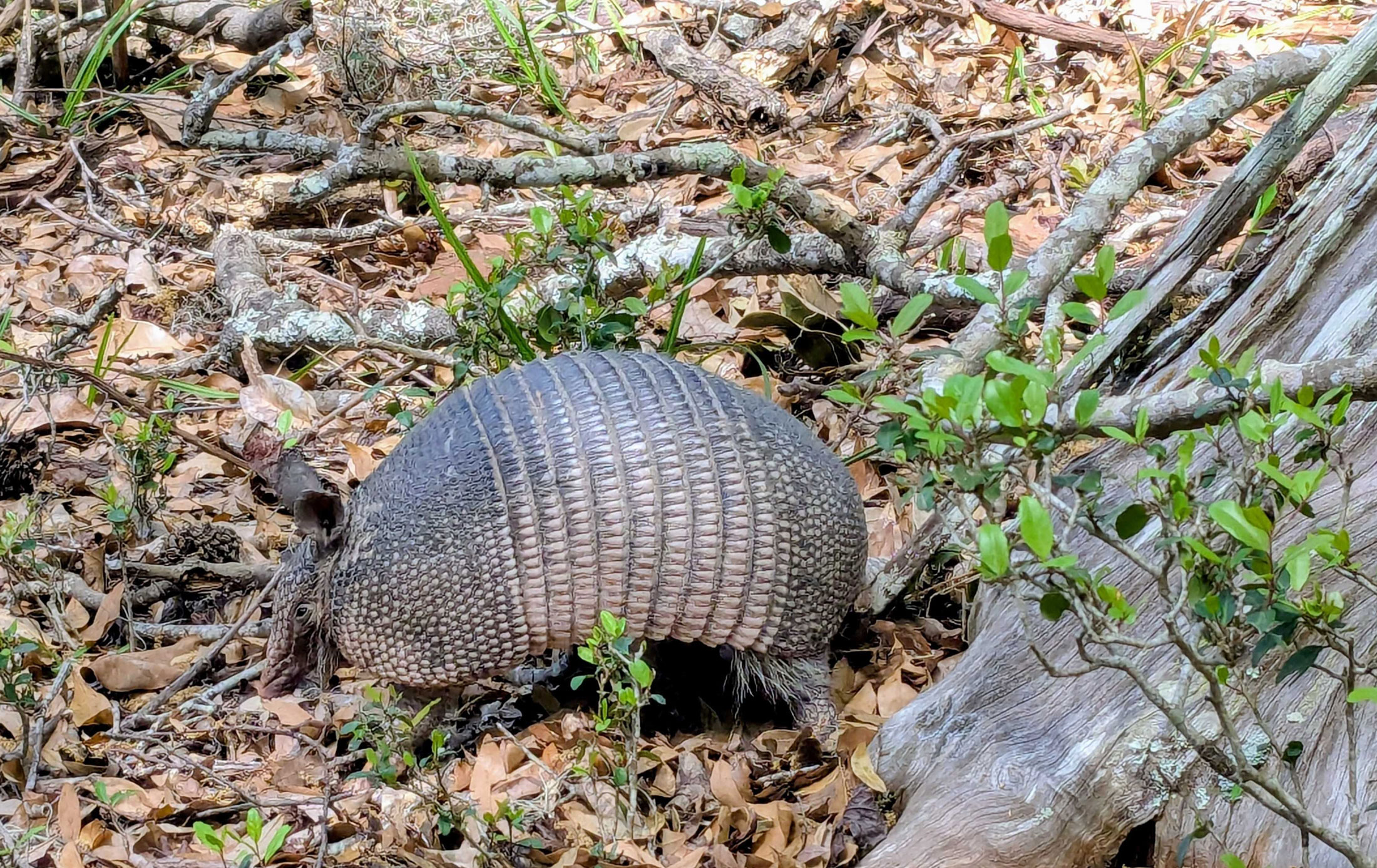
With their tough, leathery shells, interesting digging habits, and pattern of giving birth to identical quadruplets, nine-banded armadillos (Dasypus novemcinctus) are full of quirks. These solitary creatures are skilled burrowers and surprisingly adaptable—so much so that they’ve expanded their range to include some of the highest elevations in Great Smoky Mountains National Park.
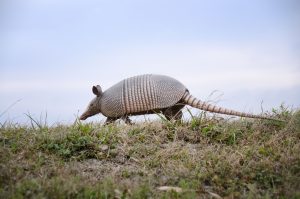
There is a “funky history” to the distribution of armadillos, said Tim J. Gaudin, a University of Chattanooga Foundation professor in the Department of Biology, Geology, and Environmental Science at the University of Tennessee at Chattanooga. In fact, they have been expanding through the states for a long time.
Native to South and Central America, nine-banded armadillos—named for the number of bands on their bony armor, despite the fact that the number can range from seven to 11—briefly appeared in the Southeastern states during the Ice Age before disappearing and retreating back into Central America. Around the 1850s, armadillos reappeared in the United States with sightings in Brownsville, Texas. Eventually, they began expanding their range northward once more, becoming established in the Southeast between Texas and Louisiana.
Their range began to shift again in the 1920s when humans accidentally introduced them to Florida. As populations expanded from Florida and Texas, the two groups eventually converged in Georgia during the 1980s. Since then, their range has continued to grow steadily—by 2007, they had reached middle and eastern Tennessee. Though about 20 armadillo species exist worldwide, the nine-banded armadillo is the only one found in the United States.
Despite long-held beliefs that armadillos are strictly warm-weather animals, their expansion tells a different story. Since armadillos were first spotted in Great Smoky Mountains National Park in 2019, nine armadillo sightings have been reported in the park through iNaturalist, an app park visitors can use to document plant and wildlife observations. These sightings occurred at locations such as Cades Cove, Tremont, and Smokemont, as well as high-elevation areas like Kuwohi and Newfound Gap, where the average January day sees a low of about 22 degrees Fahrenheit. Five of these nine observations were of dead animals, mostly found along roadways.
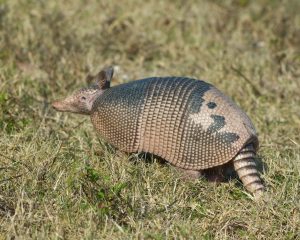
Historically, scientists believed that armadillos favored warmer climates, making these high-elevation appearances particularly noteworthy. Their presence provides new information on just how adaptable these animals can be.
“Armadillos change their activity pattern,” Gaudin explained. “In the summer, when it’s warm, they’re out at night almost exclusively. But in the winter, they start coming out during the day when it’s warmer. They appear, as with many things, to be very adaptable and to figure out ways to deal with the cold.”
As armadillos continue expanding into areas that hadn’t anticipated them, some people see them as an invasive species. However, this perception could do more harm than good, and affect how these animals are perceived and treated.
“I think by them having the invasive label attached to them, it tends to make people just want to shoot them and not try to understand them,” Gaudin said.
Though armadillos are establishing themselves in places they had not previously existed—and might occasionally be getting inadvertent help from humans by catching rides on truck beds—classifying them as ‘invasive’ may not be entirely correct.
“Normally, when we get a new invasive or exotic species, it’s because it has been moved accidentally from its native range into a new habitat,” said Will Kuhn, director of science and research for park partner Discover Life in America, which works to document all forms of life found in the Smokies. “Armadillos are different though since they’re probably for the most part not being moved by people.”
Their presence in Great Smoky Mountains National Park does raise questions about their overall impact.
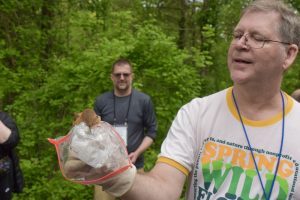
“It’s possible that as their numbers grow, they could cause rooting damage similar to the truly invasive European hogs in the park, but it’s too early to tell what kind of major effects they will have—if any—on the Smokies ecosystem,” said Kuhn.
A common concern relates to how armadillos will affect other animals in the region, potentially becoming a competitor with certain mammals like spotted skunks. Their burrowing, while having the potential to improve soil health, can also damage lawns, gardens, and any other area that has moist soil. However, armadillos have remained relatively understudied throughout the years, and much remains unknown. Even basic information about how they might affect their new environments is missing from the body of research.
“The traditional way that people who study mammals study them is they set out traps and they capture them,” Gaudin said. “It turns out it’s really hard to trap armadillos because they feed on stuff in the soil. Usually, the way we get animals into traps is by using bait, but armadillos don’t really seem to go for bait because you can’t put a pile of live bugs in a trap—the bugs would run away.”
As a result, researchers are turning to motion-activated cameras placed in areas where armadillos are likely to appear. These tools allow scientists to observe them in their natural habitats and steadily expanding range—which now includes parts of the Smokies.
Their appearance in the Smokies has been documented through Discover Life in America and iNaturalist users. DLiA is best known for coordinating the Smokies All Taxa Biodiversity Inventory—a massive, ongoing collaborative project between scientists and park visitors to document every species within the park. The nine-banded armadillo is also on DLiA’s Smokies Most Wanted list, an initiative within the ATBI that invites park visitors to help submit observations of specific species for which more information is needed. Through these efforts, DLiA plays a key role in tracking the armadillo’s expansion into the region and providing valuable data to better understand these animals.
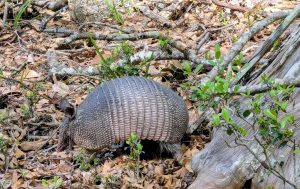
Over the past decade, the armadillo’s rate of expansion has doubled, but scientists aren’t sure why. With their adaptability and general indifference to human presence, these animals are more than capable of settling near towns and neighborhoods. As a result, more communities may soon find themselves sharing space with armadillos—and adjusting to the unexpected changes that come with them.
“I’d like to see money spent on figuring out what they’re doing, what their role in the ecosystem is,” Gaudin said. “They’re not invasive in the classic sense. We didn’t bring them in there—they brought themselves in. And we still don’t really know why they’re doing so well and are spreading much faster than they used to. There’s a lot to learn about them.”
See an armadillo? If you’re able, snap a photo and upload it to iNaturalist to help scientists better understand these mysterious creatures. However, use caution. If startled, armadillos may jump up to three feet vertically in the air and have been known to break teeth and noses in the process. In rare cases, they may also carry leprosy. Avoid touching armadillos or approaching them too closely.
Subscribe to get the latest posts sent to your email.
The Great Smokies Welcome Center is located on U.S. 321 in Townsend, TN, 2 miles from the west entrance to Great Smoky Mountains National Park. Visitors can get information about things to see and do in and around the national park and shop from a wide selection of books, gifts, and other Smokies merchandise. Daily, weekly, and annual parking tags for the national park are also available.